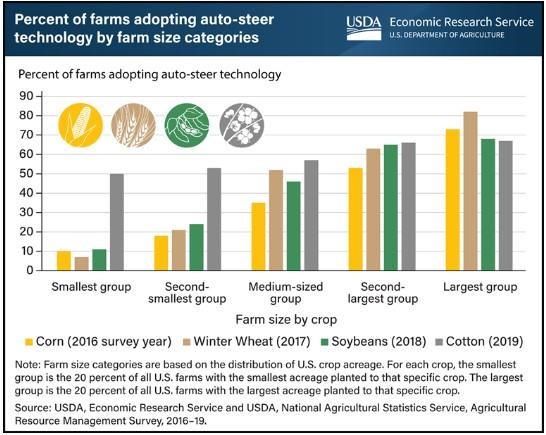
U.S. farms are adopting precision technologies at different rates, with the largest farms adopting auto-steer guidance technology at significantly higher rates. USDA, Economic Research Service researchers used data from four successive Agricultural Resource Management Surveys (ARMS) to assess the adoption of precision agriculture technologies across four major field crops. After sorting farms into five equally sized groups based on farm size, they found that the largest farms across all commodities had adopted guidance at the highest rates. Specifically, of farms growing corn in 2016, 73 percent of farms in the largest size category adopted guidance. The rates were similar for the group of largest farms growing other commodities in later years: 82 percent of the largest winter wheat farms in 2017, 68 percent of the largest soybean farms in 2018, and 67 percent of the largest cotton farms in 2019. Conversely, among the smallest farms, adoption of guidance systems was much lower: 10 percent of the smallest corn farms in 2016, 11 percent of the smallest soybean farms in 2018, and 7 percent of the smallest winter wheat farms in 2017, with the exception of cotton, which starts at a relatively high rate of 50 percent for the smallest cotton farms in 2019. Adoption rates vary based on field terrain, soil characteristics, the scale and scope of production, and farmers’ risk preferences. Other factors affecting adoption rates include the type of crop produced and farmers’ socioeconomic characteristics, such as age, education level, and years of experience. This chart appears in the Economic Information Bulletin Precision Agriculture in the Digital Era: Recent Adoption on U.S. Farms, published in February 2023.